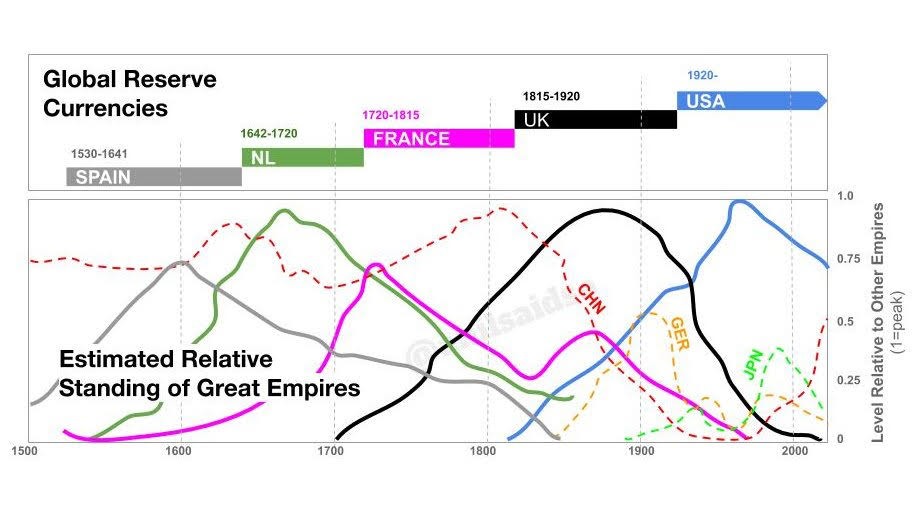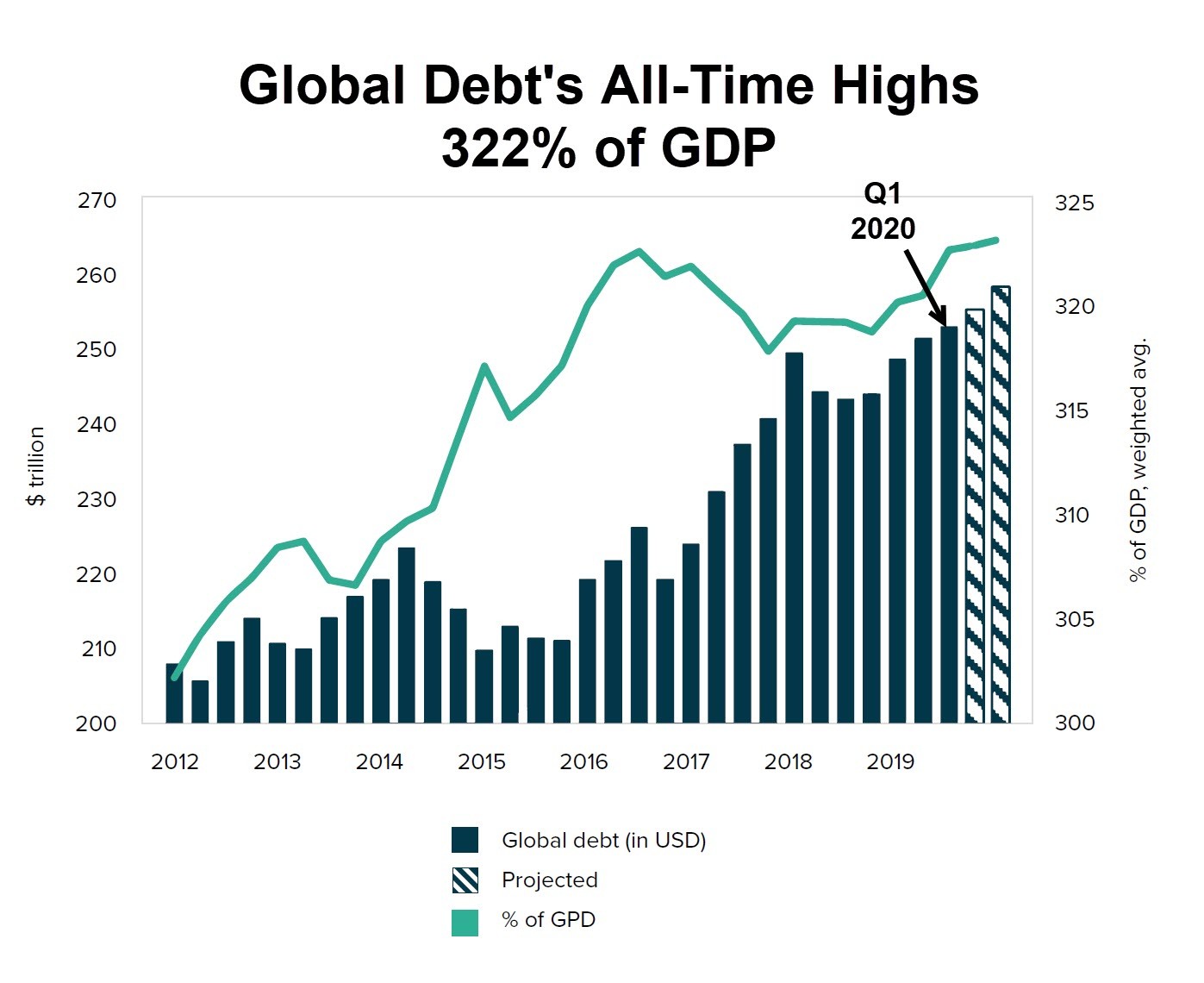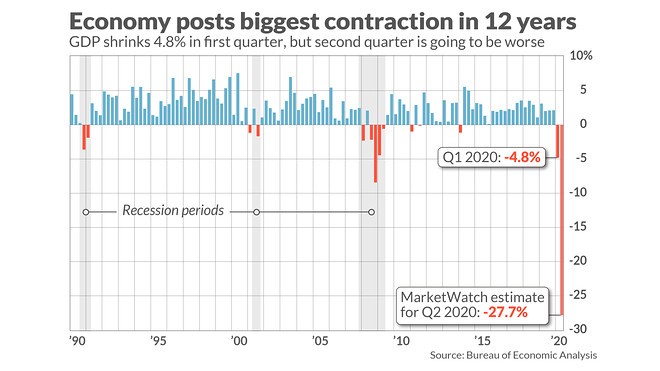Market Lab Report / Dr. K's Crypto-Corner
by Dr. Chris Kacher
The (R)Evolution Will Not Be Centralized™
 U.S. Dollar's Days Numbered?
U.S. Dollar's Days Numbered?Going back 500 years and beyond, every fiat currency has had a limited shelf life. In terms of the relative standing of great empires through the ages, the U.S. is on the way down (blue line) while China is on the way up (dotted red line). A well thought out article was recently written by Ray Dalio of Bridgewater on how money, debt, interest rates, and government create the long term debt cycles which lead to the destruction of the world's reserve currency at that time and gets replaced by a new reserve currency from another country. Ray Dalio runs the world's largest, most successful hedge funds, Bridgewater. He examines issues from many angles, looking back at numerous historical examples, to gain a decent understanding. Dalio's article underscores some of the work I've published on why the stock market probably won’t retest March lows but continue higher in sloppy fashion with sharp, second order corrections along the way due to the unprecedented economic lockdown/house arrest.
A Thousand Years of History
As for a tipping point, monetary policy addiction by leading governments has always led to the same result if a thousand years of history is any guide. While the trend shows the yuan gaining momentum against the dollar, it doesnt automatically mean a polar shift where the yuan replaces the dollar as the world's reserve currency as such shifts take time, and then there is no guarantee that the yuan will emerge as the world's reserve currency.
If you take the 50k foot view, the long view, the cycle we are seeing unfold is similar to all the others when examining many centuries of history which is why all reserve currencies go from cradle to grave without exception.
Typically a new reserve currency is born as a new major cycle begins which occurs after a global collapse of sorts, where a new world order rises, and with it, a new monetary system and new political system. The last one began in 1945 over a period of rebuilding and prosperity when the U.S. was a creditor nation.
Back then, the U.S. government did not bail out the people. The people bailed out the government. It raised taxes dramatically, borrowed money from the people via war bonds, then the people were paid back after the war. Today, a material number of people are broke, companies are broke, governments are broke, and the wealth gap has never been wider.
Post World War II, income growth exceeded debt-service payments. The Fed continued to stimulate credit which continued to boost economic growth. The fuel in the interest rate tank was on full, post-World War II. But since bond yields spiked in the early 1980s, the fuel in the tank has gradually been depleted over the last 4 decades to where it stands today, near empty.
This leads us to where we are today, as the record levels of debt wait to be restructured, which has vast implications as history has shown as it represents the tipping point into a new monetary system, domestic order, and ultimately the world order. A global war has historically been the final ingredient for big change. The cycle is then complete and starts again, at least based on the last millenium's worth of global economic cycles.
As Mark Twain said, "History doesnt repeat but it often rhymes." The bursting of the debt bubble, or more gently known as debt restructuring, will lead to a severe global economic contraction. Given the large wealth gap, this will spur social unrest within nations and against other nations. This internal and external fighting will lead to domestic and international political and structural transformations.
All that said, another wildcard which the likes of Ray Dalio et al have not considered is the exponential growth of tech- AI, VR, blockchain, et al which will help elevate health care, logistics, e-learning/education, work-from-home, and home entertainment, among other industries. Stocks that dominate these areas are the FAANG names as well as MSFT, AMD, and maybe INTC. Cybersecurity companies such as OKTA and QLYS also stand to benefit. OKTA and QLYS had pocket pivots the other week but have since pulled back to their respective moving averages. QLYS reports earnings in 6 days. Note, these names are for watch lists which does not mean to just go out and buy. Always take any buys in context with the overall market. The market remains vulnerable to news driven, sharp pullbacks so should you wish to go long any position, always obey your stops. If you are a shorter term trader, keep them tight. If you are longer term oriented, you don't have to wait for your sell signal to hit, often at a 50-dma violation, should the market appear as if it may have a short but sharp correction. Of course, part of the risk is some never reenter the position which then leaves them behind. Fortunately, we have provided plenty of reentry or initial buying strategies via constructive pullbacks after pocket pivots or buyable gap ups, undercut & rally formations, and volume dry-ups.
So maybe this time is different. So far, liquidity has never been this unlimited. Yes, interest rates have been at 0% but only for very brief periods such as in 2008, and not in the 1930s as only 3-mo T-bills were near 0% while the discount rate remained above 1-2% (roughly). Global debt is at all-time highs, or 322% of GDP.


So Where is the Stock Market likely to Head Next?
The question over the shorter term is which factors will prevail. It's a contest between limitless liquidity vs. horrible economic numbers which the markets have priced in vs. second order effects which are unknowns not yet priced in vs. extended lockdowns which would put selling pressure on the markets. Price/volume on the NASDAQ Composite is showing more up days on higher volume than down days on higher volume showing institutions continue to be net buyers of this sharp rally. The rolling 20 day count of distribution days is just 2. But keep stops tight as any second order effect such as we observed when oil futures went negative for the first time in history, could introduce another short, sharp shock into the markets. Then for longer term trend followers, use our various buying strategies to re-enter your position. The nice thing about trading strategies is there's more than one way to skin a cat. Finding a style that fits one's trading personality is key as we have discussed in our books and articles. And should market conditions go against that style, there is nothing wrong with sitting on the sidelines. As Livermore once said, more money is lost overtrading the markets when the sidelines is sometimes the best place.
